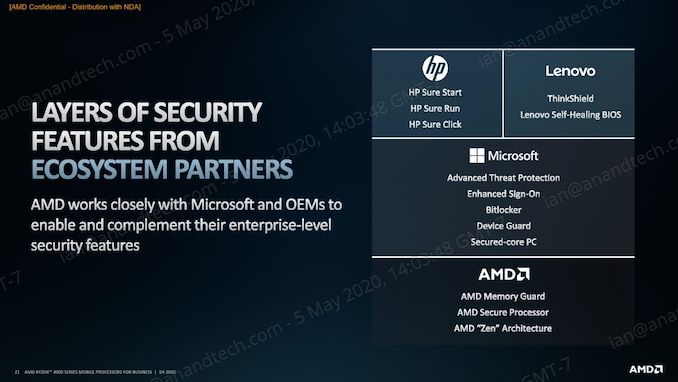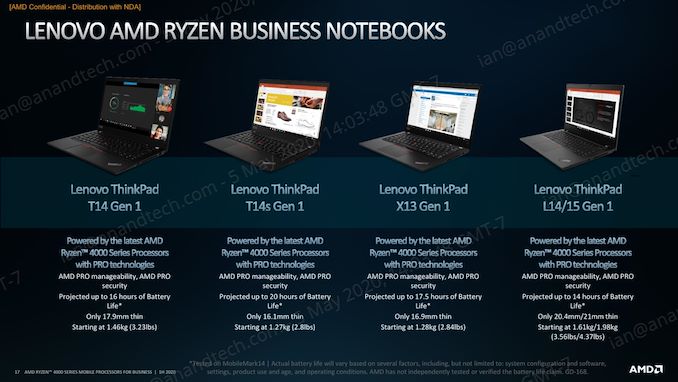AMD Announces Ryzen Pro 4000 for Mobile: 8 Cores, 15 W, 4.1 GHz
by Dr. Ian Cutress on May 7, 2020 9:01 AM EST
On the back of AMD’s successful Ryzen Mobile 4000 series launch for consumer laptops, the company today launching its range of commercial processors from the same family. These processors are designed for the standard commercial verticals typically associated with company contracts, education deployments, medical use cases and any environment that requires a level of manageability across its workforce. The new AMD processors have up to eight of the latest Zen 2 cores, up to Vega 7 compute graphics, and are built on the latest TSMC 7nm process node technology.
AMD’s Ryzen Pro hardware, much like Intel’s vPro, are commercial platforms. Commercial markets are similar to consumer markets, but rather than aiming to sell to users individually, commercial markets involve company-wide distribution of large numbers of units that are managed by a central IT team. For example, a global company might request 10000 units as part of its 3-5 year cyclical upgrade strategy – these units might be purchased outright from an OEM, or leased, depending on the contract. As a result, these devices typically have to adhere to a rigid structure to ensure full administrative capabilities (deployment, imaging, monitoring) while also minimizing downtime. If a company wants to deploy a stable confirmed software update over those 10,000 machines, it could be done at the click of a button on the admin side.
While this seems like an easy adjustment at the hardware level, it can be asked about what happens at the processor level to enable this. This is why AMD creates its own Ryzen Pro product lines specifically for these markets. These processors have specific features turned on, that aren’t turned on in consumer products – this also means that these processors require additional validation at the manufacturing level to ensure that these Pro features work.
This includes security, such as AMD’s Memory Guard which enabled full encryption for when a system is in hibernate mode/ a consumer laptop will still have data in memory, or in a stored page file, potentially unencrypted, open to attack. However a Ryzen Pro machine will keep it encrypted while in that hibernate mode. There are also additional collaborations on security with OEM partners, such as Lenovo’s Self-Healing BIOS and ThinkShield, HP’s Sure like of security, and then additional benefits in Windows.
There is also additional ecosystem stability metrics that these customers often require, such as a guarantee of company shipments of parts for at least 24 months with no iterative updates (e.g. the chip isn’t moved to a new process), and a guarantee that there will be OS image stability over 18 months. This isn’t unique to AMD, however it is part of the AMD package. Obviously AMD is citing the recent rise in Work-From-Home users as the key time to launch its new product line.
For the new hardware, AMD will be launching three Ryzen Pro 4000 series processors. These include a Ryzen 7 Pro, a Ryzen 5 Pro, and a Ryzen 3 Pro, all aimed at mobile devices with a TDP of 15 W.
| AMD Ryzen Pro 4000 Mobile Processors | |||||||
| AnandTech | Cores Threads |
Base Freq |
Turbo Freq |
L3 Cache |
GPU | GPU Freq |
TDP |
| Ryzen 7 Pro 4750U | 8 / 16 | 1700 | 4100 | 8 MB | Vega 7 | 1600 | 15 W |
| Ryzen 5 Pro 4650U | 6 / 12 | 2100 | 4000 | 8 MB | Vega 6 | 1500 | 15 W |
| Ryzen 3 Pro 4450U | 4 / 8 | 2500 | 3700 | 4 MB | Vega 5 | 1400 | 15 W |
These improve over the previous generation Ryzen Pro 3000 series processors by increasing core counts across the stack, increasing the underlying microarchitecture, and all within the same power. As a result, AMD is quoting ~29% increased single threaded performance, ~132% increased multithreaded performance, and ~13 increased graphics performance for the Ryzen 7 Pro. Against comparative Intel parts, AMD is quoting up to 32% better performance in digital content creation and productivity, in benchmarks the company believes emulate real world performance.
The first products with the new Ryzen Pro 4000 Mobile Series processors are from Lenovo, namely several series of ThinkPads, which are the often quoted brand identifier that a product is ready for commercial use. The T14, T14s, X13, and L14/L15 Series (all Gen 1) will all use these new processors, offering 14-20 hours of battery life depending on the model. Technically Lenovo already announced the T14 and T14s back in February.
These machines will be available shortly, depending on region. Other Ryzen Pro devices are expected to be announced over the course of the next few months.
Related Reading
- New Lenovo ThinkPad Laptops: AMD Ryzen 4000 Pro or Intel 10th Gen
- AMD Announces Ryzen Pro 3000 Series CPUs For Q4
- Lenovo's ThinkPad X395: A 13.3-Inch AMD Ryzen Pro-Based Ultraportable
- AMD Launches 2nd Gen Ryzen Pro & Athlon Pro APUs
- HP Unveils ProDesk 405 G4 Desktop Mini PC: An SFF Ryzen Pro Desktop
- The Lenovo ThinkPad A285 (12.5-Inch) Review: Ryzen Pro Gets Down to Business
- AMD Launches Ryzen Pro with Vega: Mobile APUs and Desktop APUs













24 Comments
View All Comments
Santoval - Friday, May 8, 2020 - link
"TSMC has slightly less capacity than Intel".A *lot* of things can change in 7 years in the industry of semiconductor manufacturing, so posting a ... 7-year old link (!!) about TSMC to back up the above claim of yours makes no sense at all. The Intel PDF is even older because it mentions "2013 projected" about two planned Intel fabs and "In addition, by the second half of 2011 we expect..." So it was compiled in the first half of 2011! 9 full years ago!! I think my most surprised possible, dumbfounded actually, "Really?!?" fully applies here.
I post a link from early 2020 below to, er, "update" your numbers. The gist is that Intel is not even at the top 5 fabs anymore in wafer output per month. They fab 817,000 200mm-equivalent wafers per month as of December 2019. Samsung top the list with 2.9 million (200mm-equiv.) wafers per month (with ~2/3 of that being DRAM and NAND) and TSMC are second with 2.5 million wafers per month :
https://www.icinsights.com/news/bulletins/Five-Sem...
Santoval - Friday, May 8, 2020 - link
"so there are rumours they are moving from Intel to their own in-house ARM-based design."They are no longer rumors, at least according to Bloomberg. They will start selling -in a gradual transition starting from their lowest powered models- Mac computers with ARM cores based on their upcoming A14 SoC next year. The core count will be 12 cores and it will be fabbed at TSMC's 5nm node. While it *is* an April article it was posted on April 23, so it is certainly not an April fools piece :
https://www.bloomberg.com/news/articles/2020-04-23...
zamroni - Thursday, May 7, 2020 - link
Some of the reasons:1. Thunderbolt port certification is limited by Intel to Intel platforms only.
2. Power consumption is not good up to 3000U series
phoenix_rizzen - Monday, May 11, 2020 - link
1 is incorrect, as of about a year ago. Intel released the TB3 specs for anyone to implement, royalty-free. I believe you still need to get the implementation certified by Intel, but there are several AMD-based systems (laptop and desktop) with official TB3 support.LiKenun - Thursday, May 7, 2020 - link
Though technically supported, Pro part products—unfortunately—don’t typically come with ECC memory going by what’s currently being sold from laptop manufacturers using the current generation of Pro parts. I can find ECC RAM easily on Amazon, but getting a CPU to work with it and the motherboard to declare support is rocket science. I don’t understand what’s up with the resistance to making ECC accessible.brucethemoose - Thursday, May 7, 2020 - link
Its hard to market, maybe too hard to justify the validation costs and (small) price premium.That sounds silly, but getting OEMs to use symmetric dual channel memory in consumer stuff is already like pulling teeth.
PeachNCream - Thursday, May 7, 2020 - link
Or dual channel at all. A fair number of consumer notebooks are stuck with a single DIMM slot or the soldered down equivalent of a single DIMM and are consequently without the additional bandwidth that the iGPUs they universally use depend on for graphics performance.rrinker - Thursday, May 7, 2020 - link
Or a soldered down 8GB and a single slot - so you can add another 8 and get symmetrical dual channel, but only a total of 16GB, or you can put a 16GB module and get a total of 24GB but no longer symmetrical.PeterCollier - Saturday, May 9, 2020 - link
Erm, speaking of mismatched sizes of RAM... Ever heard of flex mode operation?Zibi - Thursday, May 7, 2020 - link
I'd guess the reasons against offering ECC might be along the following lines:1. ECC DIMMs tend to be slower (higher CL) and more expensive.
2. ECC DIMMs also tend to visible show their bad shape, which leads to RMA - in the DataCenter environment we recently got 1 DIMM malfunctioned per about 10 servers.
This is maybe not the best example, but my take is like that - you may got suprisingly big percentage of DIMMs that will be either DOA or will break during the guarantee period.
Vendors need to factor this into the cost, and the margins in this segment are really tight.